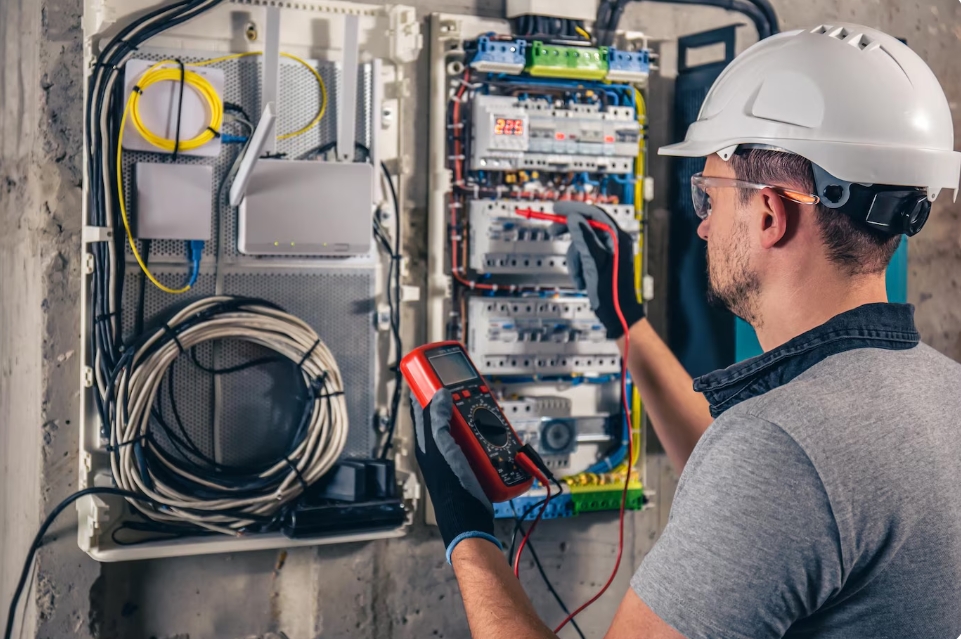Practicing electrical engineering MCQ questions is a smart way to strengthen your understanding of key concepts. This article provides a carefully selected set of multiple choice questions with answers, covering topics like basic circuits, electrical machines, power systems, electronics, and control systems. These questions are useful for students, exam preparation, and quick revision. Whether you’re getting ready for competitive exams or just want to test your knowledge, this collection offers a helpful and time-saving resource. Go through each question and answer to improve your grasp of core concepts in electrical engineering with clear and structured practice.
Electrical Engineering MCQs

Q. Ohm’s Law states that:
A) Voltage = Current / Resistance
B) Current = Voltage / Resistance
C) Resistance = Voltage × Current
D) Power = Voltage × Resistance
Answer: B
Q. Unit of electric current is:
A) Watt
B) Ohm
C) Ampere
D) Volt
Answer: C
Q. Which material is a good conductor of electricity?
A) Wood
B) Copper
C) Plastic
D) Glass
Answer: B
Q. 1 kWh equals:
A) 3600 J
B) 1.6 × 10⁻¹⁹ J
C) 3.6 × 10⁶ J
D) 1000 J
Answer: C
Q. Which device stores electrical energy?
A) Diode
B) Inductor
C) Capacitor
D) Resistor
Answer: C
Q. Power factor in purely resistive circuit is:
A) 0
B) 1
C) -1
D) 0.5
Answer: B
Q. SI unit of resistance is:
A) Ampere
B) Farad
C) Volt
D) Ohm
Answer: D
Q. In an AC circuit, the power factor is:
A) The cosine of the phase angle
B) The sine of the phase angle
C) Always zero
D) Always one
Answer: A
Q. The instrument used to measure current is:
A) Voltmeter
B) Ammeter
C) Ohmmeter
D) Wattmeter
Answer: B
Q. Which law states that the sum of currents entering a junction equals the sum leaving?
A) Ohm’s Law
B) Kirchhoff’s Voltage Law
C) Kirchhoff’s Current Law
D) Faraday’s Law
Answer: C
Q. The opposition to current in an AC circuit is called:
A) Resistance
B) Capacitance
C) Inductance
D) Impedance
Answer: D
Q. A device that converts DC to AC is called:
A) Rectifier
B) Transformer
C) Inverter
D) Converter
Answer: C
Q. Which of the following is a passive component?
A) Diode
B) Transistor
C) Op-amp
D) Resistor
Answer: D
Q. A transformer operates on the principle of:
A) Electromagnetic attraction
B) Self-induction
C) Mutual induction
D) Capacitive coupling
Answer: C
Q. A short circuit means:
A) High resistance path
B) Infinite resistance
C) Zero resistance path
D) No connection
Answer: C
Q. In a series circuit, the current is:
A) Divided equally
B) Minimum at the last resistor
C) Same through all components
D) Zero
Answer: C
Q. Unit of Capacitance:
A) Henry
B) Ohm
C) Farad
D) Tesla
Answer: C
Q. AC stands for:
A) Alternating Capacitance
B) Alternating Current
C) Actual Current
D) Average Current
Answer: B
Q. Which of the following is not a source of electrical energy?
A) Battery
B) Generator
C) Transformer
D) Solar cell
Answer: C
Q. Electric power is measured in:
A) Joules
B) Amperes
C) Watts
D) Volts
Answer: C
Q. The main function of a transformer is to:
A) Convert AC to DC
B) Change voltage levels
C) Convert mechanical to electrical energy
D) Store electrical energy
Answer: B
Q. The part of a DC machine where armature winding is placed is called:
A) Stator
B) Rotor
C) Commutator
D) Yoke
Answer: B
Q. Which of the following machines is not self-starting?
A) DC motor
B) Induction motor
C) Synchronous motor
D) Universal motor
Answer: C
Q. The frequency of generated voltage in an alternator depends on:
A) Voltage and power
B) Speed and number of poles
C) Load and torque
D) Resistance and current
Answer: B
Q. The unit of magnetic flux is:
A) Tesla
B) Weber
C) Henry
D) Ampere
Answer: B
Q. In a transformer, core is laminated to:
A) Reduce copper losses
B) Reduce hysteresis losses
C) Reduce eddy current losses
D) Increase flux leakage
Answer: C
Q. Which part of the transformer is used to cool it?
A) Laminated core
B) Conservator
C) Radiator
D) Breather
Answer: C
Q. An induction motor works on the principle of:
A) Electrostatic induction
B) Electromagnetic induction
C) Magnetic repulsion
D) Static electricity
Answer: B
Q. The slip of an induction motor is:
A) Always 0
B) Always 1
C) Between 0 and 1
D) Greater than 1
Answer: C
Q. Which machine can run on both AC and DC supply?
A) Synchronous motor
B) Universal motor
C) Induction motor
D) Stepper motor
Answer: B
Q. Which motor is preferred for electric traction?
A) DC series motor
B) Synchronous motor
C) Induction motor
D) Repulsion motor
Answer: A
Q. The no-load current in a transformer is:
A) In phase with the voltage
B) Lagging the voltage by 90°
C) Leading the voltage
D) Lagging the voltage by a small angle
Answer: D
Q. The armature of a DC generator is:
A) Stationary
B) Rotating
C) Always grounded
D) Made of copper winding only
Answer: B
Q. Which loss occurs in the core of a transformer?
A) Hysteresis loss
B) Copper loss
C) Brush loss
D) Friction loss
Answer: A
Q. The commutator in a DC machine:
A) Converts AC to DC
B) Converts DC to AC
C) Provides mechanical support
D) Acts as a cooling device
Answer: A
Q. The efficiency of a transformer is maximum when:
A) Iron losses = Copper losses
B) Load is minimum
C) Core is large
D) Voltage is high
Answer: A
Q. Squirrel cage rotor is used in:
A) Synchronous motor
B) DC motor
C) Single-phase motor
D) Induction motor
Answer: D
Q. In DC motors, brushes are used to:
A) Transfer energy to the core
B) Reduce the losses
C) Provide electrical contact to the commutator
D) Lubricate the shaft
Answer: C
Q. Which motor has highest starting torque?
A) DC shunt motor
B) DC series motor
C) Synchronous motor
D) Universal motor
Answer: B
Q. Transformer rating is given in:
A) kW
B) kVA
C) HP
D) kVAR
Answer: B
Q. The usual frequency of AC supply in India is:
A) 50 Hz
B) 60 Hz
C) 100 Hz
D) 25 Hz
Answer: A
Q. A three-phase system consists of how many conductors?
A) 2
B) 3
C) 4
D) 5
Answer: C
Q. Which of the following is a non-renewable source of energy?
A) Solar
B) Wind
C) Coal
D) Hydro
Answer: C
Q. In a power station, the power factor is generally kept:
A) Zero
B) Unity
C) Lagging
D) Near unity
Answer: D
Q. Load factor is defined as:
A) Peak load / Average load
B) Average load / Peak load
C) Average load / Installed capacity
D) Peak load / Installed capacity
Answer: B
Q. The underground cable used for transmission is:
A) ACSR
B) PVC
C) XLPE
D) Copper bare conductor
Answer: C
Q. A lightning arrester is used to protect equipment from:
A) Switching surges
B) Lightning surges
C) Overcurrent
D) Voltage drops
Answer: B
Q. Which of the following systems delivers power over long distances?
A) DC system
B) Single-phase AC
C) Three-phase AC
D) All of the above
Answer: C
Q. The corona effect is associated with:
A) Motors
B) Transformers
C) Transmission lines
D) Generators
Answer: C
Q. Overhead transmission lines are supported by:
A) Wooden poles
B) RCC poles
C) Steel towers
D) All of the above
Answer: D
Q. The main cause of power loss in transmission lines is:
A) Inductance
B) Capacitance
C) Resistance
D) Reactance
Answer: C
Q. The tariff is a charge for:
A) Fuel
B) Power consumed
C) Equipment used
D) Power generation only
Answer: B
Q. In India, the transmission voltage level is commonly:
A) 220 V
B) 11 kV
C) 33 kV
D) 132 kV
Answer: D
Q. Which type of bus is used in a substation?
A) Ring bus
B) Main bus
C) Double bus
D) All of the above
Answer: D
Q. The efficiency of thermal power plants is generally in the range of:
A) 10–20%
B) 20–30%
C) 30–40%
D) 60–70%
Answer: C
Q.Surge impedance of transmission line is measured in:
A) Ohms
B) Volts
C) Amps
D) Watts
Answer: A
Q. The device used for isolating a part of the system is:
A) Circuit breaker
B) Isolator
C) Relay
D) CT
Answer: B
Q. A relay operates when:
A) Normal current flows
B) Fault current flows
C) Voltage drops
D) Temperature rises
Answer: B
Q. Which transmission line has the least voltage drop?
A) Copper
B) Aluminium
C) ACSR
D) All same
Answer: A
Q. Which power plant has the lowest running cost?
A) Thermal
B) Nuclear
C) Hydro
D) Diesel
Answer: C
Q. For a silicon diode, the forward voltage drop is typically around:
A) 0.1 V
B) 0.3 V
C) 0.7 V
D) 1.2 V
Answer: C
Q.The small-signal voltage gain of a common-emitter amplifier is given by:
A) gm × ro
B) ro / gm
C) -gm × RC
D) RC / gm
Answer: C
Q.In a JFET, the pinch-off voltage is the voltage at which:
A) Current stops
B) Drain current becomes zero
C) Channel is completely depleted
D) Maximum drain current flows
Answer: C
Q. The main function of a Zener diode is to:
A) Rectify AC
B) Limit voltage
C) Control current
D) Act as a switch
Answer: B
Q. The bandwidth of an amplifier is defined as the range between:
A) 0 dB and -3 dB
B) -3 dB points
C) -10 dB and -20 dB
D) Center frequency ± 1 Hz
Answer: B
Q. If two capacitors of 2 μF and 4 μF are connected in series, the total capacitance is:
A) 6 μF
B) 2 μF
C) 1.33 μF
D) 0.5 μF
Answer: C
Q. Which of the following is not a valid assumption for ideal Op-Amp?
A) Infinite input resistance
B) Zero output resistance
C) Infinite bandwidth
D) Finite open-loop gain
Answer: D
Q.The condition for maximum power transfer in AC circuits is:
A) Load resistance = Source resistance
B) Load impedance = Complex conjugate of source impedance
C) Load impedance = Source impedance
D) Load reactance = Source reactance
Answer: B
Q. A MOSFET is a:
A) Voltage controlled current source
B) Current controlled voltage source
C) Voltage-controlled voltage source
D) Current-controlled current source
Answer: A
Q.The slew rate of an op-amp is defined as:
A) dVout/dt
B) dVin/dt
C) Vout × Vin
D) Gain × Bandwidth
Answer: A
Q. In an n-channel MOSFET, the conducting channel forms when:
A) VGS < Vth
B) VGS = 0
C) VGS > Vth
D) VDS < VGS
Answer: C
Q. The Q-point of a transistor amplifier is defined as:
A) Point of minimum output
B) Cutoff region
C) Point of maximum efficiency
D) Point of bias with no input signal
Answer: D
Q.In BJT, the region where both emitter-base and collector-base junctions are forward biased is called:
A) Cutoff
B) Active
C) Inverse active
D) Saturation
Answer: D
Q.The open-loop gain of an ideal Op-Amp is:
A) 1
B) 10
C) 10⁵
D) Infinite
Answer: D
Q. Thermal runaway in a transistor is due to:
A) High collector voltage
B) Negative feedback
C) Decrease in base current
D) Positive feedback between temperature and collector current
Answer: D
Q. A Schmitt trigger is used to:
A) Amplify signal
B) Convert analog to digital signal
C) Remove ripple
D) Generate sinusoidal waveform
Answer: B
Q. The dominant pole in a system response is the one with:
A) Largest magnitude
B) Smallest real part
C) Highest frequency
D) Lowest frequency
Answer: B
Q. Which of the following has the highest input resistance?
A) BJT
B) FET
C) Op-Amp
D) SCR
Answer: B
Q.The transistor configuration with highest voltage gain is:
A) Common base
B) Common emitter
C) Common collector
D) Emitter follower
Answer: B
Q. In a half-wave rectifier, the ripple factor is approximately:
A) 0.482
B) 1.21
C) 0.707
D) 1.11
Answer: B
Wrapping Up
These electrical engineering MCQ questions are designed to help you build confidence and reinforce your learning through practice. Covering a wide range of topics, they offer a quick and effective way to test your knowledge and identify areas that need more attention. Whether you’re preparing for an exam, interview, or simply revising concepts, these questions serve as a valuable resource. Keep practicing regularly to stay sharp and improve your problem-solving speed. Understanding the basics and applying them through MCQs is a proven way to succeed in electrical engineering. Stay focused, keep learning, and use these questions as your study companion.





